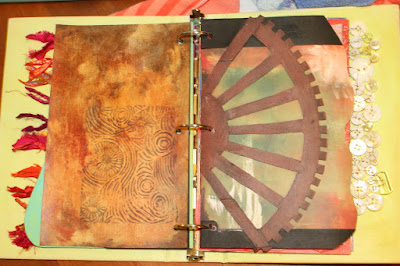


I boiled the thinly sliced orange peels, desicated ginger root and, um, I don't remember the other ingredients, but know they came from the veggie drawer in the fridge or from the compost bucket. Then, to add a solid base, I collected a few leaves from the gorgeous dogwood tree by the kitchen window, and a leave from a finished caladium. I added the leaves to the hot pot just for a few seconds. Then, I layered the ingredients on several pieces of plain white cloth. Each compost-ition (hehehe!) was topped with another piece of PWC, then sandwiched between lots of old newspapers and put in the fabulous screw press my darling husband made for me. Key instruction: change the newspaper several times the first day! Pressing out the moisture is the goal. The second day required less paper changes, and the third day even fewer paper changes. By the fourth day, the compost papers were almost dry. I finished them in a 200* oven for 12 minutes, which is about 6 minutes too long. So, I lightly spritzed them with water, put them back in the screw press with dry paper, and they're not too crispy.Love the colors, so rich! I did apply a thin coat of matte gel medium to both sides of each one.
Now, I don't know what I'll do with these 'papers', but something will need them, someday.
The other project I've been working on is this book, a challenge piece for Betsy Parker's blog, http://clay-cloth-paper-paint.blogspot.com/ . You see it listed at the left of this blog page. I was inspired by the beautiful full moon in November, the Beaver Moon and the leaves falling from that gorgeous dogwood by the kitchen window. So, that's what I've been up to lately...

*Some people compost their leftover vegetables, but fiber artists interested saving the planet may also want to slice up some "garbage paper," like Quilting Arts reader Sally Rorback has done. She based her experiments on the book Vegetable Papyrus by Maureen Richardson (Berrington Press).









